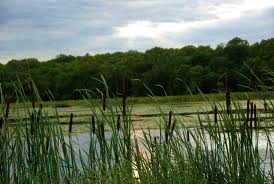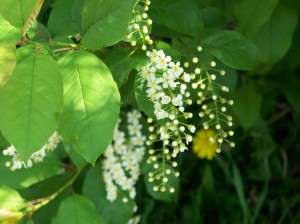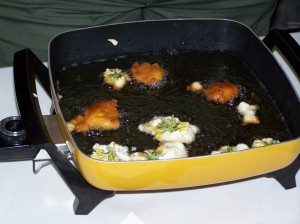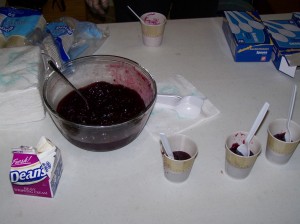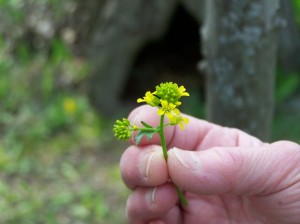This post I am calling a kind of “Aside” because it is not the type of post that I typically do, but does tie into the “Local Food” topic in a way you may not have thought of before. I enjoying hiking and studying plants and flowers, so when an Edible Plants hike was offered at Richard Bong State Recreation Area this spring, I was intrigued.
On a sunny, warm Saturday in May, about a dozen people of all ages met for the short hike. Our naturalist seemed very knowledgeable and began our exploration right outside the Nature Center with the lovely Blue Violet or Wood Violet. These are easily recognizable, very common and so pretty, but did you know they can be eaten? Toss them in a salad or they can be candied with sugar and used as edible decorations—cupcake aficionados take note! Rose petals also can be used in this way. Bonus: violets are rich in Vitamin A and C.
Many well-known fruits such as wild cherries, raspberries and strawberries grow wild just about everywhere. These are usually smaller than commercially grown varieties, but are delicious. Eat them raw or cooked or make tea from their leaves. A lot of the plants we saw can be made into tea by steeping the leaves, which often have medicinal properties. Wild Willow bark also can be made into a tea and is a pain killer similar to aspirin!
We learned about the multi-purpose Cattail, which can be eaten at different stages throughout the year in the form of young shoots in the Spring (rather like celery,) the young “tail” that resembles corn on the cob in summer, and when the flower opens later in the summer, the pollen is like corn meal and can be added to flour to make pancakes.
Plants that we now consider to be “weeds” have been eaten for centuries. You may have heard about Dandelion tea or greens, but did you ever eat the flower? These can be dipped in batter and fried as fritters. At the end of our hike, we had a special treat as our guide prepared these and several other items for us to taste. The Dandelion fritters were quite good! (Maybe these will be the next deep-fried item to show up at the State Fair!) We also tried Water Cress and cream cheese on rye, Elderberry and Sumac jelly, Bergamot tea and a Berry Flummery (or fruity pudding) that was so easy and yummy. (See the recipe below.)
I was surprised at how many common plants were edible, like Sheep Sorrel, Burdock, Plantains, Thistle and Lamb’s Quarters. Other plants you may have seen or heard of include Mustard and wild Onion.
The main thing to know is that most of these should be young plants for the best flavor, otherwise they are bitter. Some need to be cooked, so do your homework or take a class such as this one. Do not pick plants in State Parks, or roadsides that may have been sprayed with chemicals. Don’t eat any white berry and always beware of Poison Ivy! After munching on flower fritters, I will never look at Dandelion fields the same again!
Here is the recipe for Berry Flummery, which can be made from any type of berries or combination of berries:
3 cups of Berries 2 cups of Water
¼ cup of Cornstarch ¾ cup of Sugar to taste
Cook these ingredients until thickened. Then refrigerate. This is wonderful with a little cream or your favorite vanilla ice cream or frozen custard.
Richard Bong State Recreation Area
26313 Burlington Rd. (Hwy 142)
Kansasville, WI 53139
(262) 878-5600
Interestingly enough, shortly after the hike, I happened to come across an old cookbook, “Stories and Recipes of the Great Depression of the 1930’s,” by Rita Van Amber, copyright 1986 by Van Amber Publishers. I was thumbing through it when I read how mothers valiantly struggled through the Depression to feed their families. During dry years when gardens did not do well, but weeds like Lamb’s Quarters flourished, they were canned to have something on the cellar shelves for the winter. When I first read this I was shocked. But after the edible plants hike, I came to realize that it is all a matter of what you are familiar with.
Native Americans knew the value of native plants and came to know how to use the entire plant. They had to, to survive. Settlers that came later did the same. With the convenience of grocery stores and commercially grown food we have gotten away from that knowledge, but learning even just a little about the native plants made me feel that I would never really be hungry if I was lost in the woods, because food is everywhere, Hickory nuts, Rose hips, Sumac lemonade, and more. If you want a different perspective on truly “Local” food, take a class or pick up a book on our edible plants. It will change how you think of your backyard!
Related articles
- Edible wild plants on the trail (kansastrailguide.com)
- Non-edible Poisonous Flowers to Avoid (cooking.answers.com)

